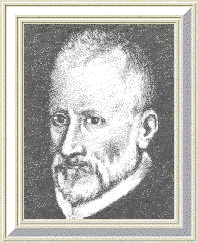 He
was a pupil of Mallapert and Firmin Lebel at St. Maria Maggiore, Rome,
where he was a choirboy from at least 1537. He became organist of St. Agapito,
Palestrina, in 1544 and in 1547 married Lucrezia Gori there; they had three
children. After the Bishop of Palestrina's election as pope (Julius III)
he was appointed "maestro di cappella" of the Cappella Giulia in Rome (1551),
where he issued his first works (masses,
1554); during 1555 he also sang in the Cappella Sistina. Two of Rome's
greatest churches then procured him as "maestro di cappella," St. John
Lateran (1555-60) and St. Maria Maggiore (1561-6), and in 1564 Cardinal
Ippolito d'Este engaged him to oversee the music at his Tivoli estate.
From 1566 he also taught music at the Seminario Romano, before returning
to the Cappella Giulia as "maestro" in 1571.
He
was a pupil of Mallapert and Firmin Lebel at St. Maria Maggiore, Rome,
where he was a choirboy from at least 1537. He became organist of St. Agapito,
Palestrina, in 1544 and in 1547 married Lucrezia Gori there; they had three
children. After the Bishop of Palestrina's election as pope (Julius III)
he was appointed "maestro di cappella" of the Cappella Giulia in Rome (1551),
where he issued his first works (masses,
1554); during 1555 he also sang in the Cappella Sistina. Two of Rome's
greatest churches then procured him as "maestro di cappella," St. John
Lateran (1555-60) and St. Maria Maggiore (1561-6), and in 1564 Cardinal
Ippolito d'Este engaged him to oversee the music at his Tivoli estate.
From 1566 he also taught music at the Seminario Romano, before returning
to the Cappella Giulia as "maestro" in 1571.
During the 1560s and 1570s Palestrina's fame and influence rapidly increased through the wide diffusion of his published works. So great was his reputation that in 1577 he was asked to rewrite the church's main plainchant books, following the Council of Trent's guidelines. His most famous mass, "Missa Papae Marcelli", may have been composed to satisfy the council's requirements for musical cogency and textual intelligibility. He was always in tune with the Counter-Reformation spirit; after his wife's death in 1580 he considered taking holy orders, but instead he remarried (1581). His wife, Virginia Dormoli, was a wealthy fur merchant's widow; his investments in her business eased his financial strains, and his last years at St. Peter's were among his most productive.
Palestrina ranks with Lassus and Byrd as one of the greatest Renaissance masters. A prolific composer of masses, motets and other sacred works, as well as madrigals, he was (unlike Lassus) basically conservative. In his sacred music he assimilated and refined his predecessors' polyphonic techniques to produce a 'seamless' texture, with all voices perfectly balanced. The nobility and restraint of his most expressive works established the almost legendary reverence that has long surrounded his name and helped set him up as the classic model of Renaissance polyphony.
His style was superbly well-controlled and his counterpoint transparent which demonstrate his ideals of serenity and balance. His compositions invariably take into account the proper accentuation or words, and often even their meaning, but without heightening their rhetoric so emphatically that the continuous flow of polyphony is broken. To ensure that the stream of counterpoint remained even and uninterrupted, he controlled his dissonances rigorously and invented melodies that introduce neither abrupt or disturbing leaps nor sudden changes of direction or pace. He often built up his compositions by repeating entire passages, simply or with variants, or by adding new voices to the original material; or he used other rational devices, like invertible counterpoint or the transposition of whole points of imitation.
Palestrina's offertories are important historically since they and Lasso's similar collection are the earliest written in free motet style, without the use of borrowed chant. He wrote most of his motets on themes of his own invention, without recourse to borrowed chants or their strict constructive devices. Palestrina's Masses contain some of his finest music. They include some works built over cantus firmi, some that paraphrase chants, some built on canonic cycles, some that parody polyphonic motets, madrigals, or chansons, and some that are entirely free of borrowed material or constructive devices.